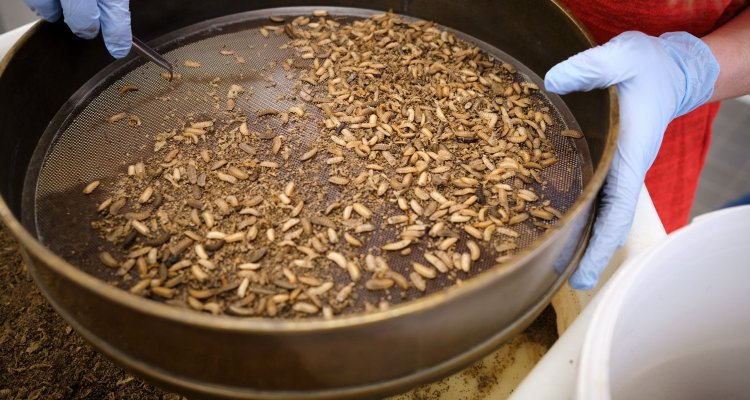
The role of waste streams and insects in the search for an alternative to soy
Soy is an important protein source for the world, primarily for animal feed. The increasing demand and large scale cultivation of soy, however, is linked to profound issues such as deforestation and biodiversity loss. Soy trade flows further exacerbate global nitrogen imbalances. Hence the increasingly loud call for alternatives. Technically, there are plenty of options, but putting these alternatives into practice requires additional steps, including regulatory changes that support faster approvals. WUR researchers will discuss sustainable and affordable alternative ingredients for animal feed in an online session for policymakers on 24 January. The session will also discuss how introduction of these alternatives may be supported from a policy perspective.
A protein alternative must fit a complex puzzle to be considered. Compound feed manufacturers determine the optimal composition of their products on a daily basis. They carefully consider each ingredient and its nutritional value. Availability, nutritional value and pricing are determining factors.
Ultimately, the compound feed industry aims to deliver a high-quality product
Alfons Jansman, a senior researcher at Wageningen Livestock Research: ‘Important constraints are used in the formulation process. The feed must deliver the necessary energy and nutrients and match the animals’ nutritional requirements. At the same time, minimum and maximum constraints are sometimes set for the inclusion of particular raw materials.’ Thus, rapeseed and sunflower seed meals (by-products of oil extraction) are both an alternative to soybean meal. Rapeseed meal, however, contain substances with a divergent taste, which may negatively influence feed intake. Jansman: ‘Ultimately, the compound feed industry aims to deliver a high-quality product that contains all the required nutrients, is easily ingested and supports adequate animal performance.’
A promising alternative
Various alternative protein sources, such as grains, legumes and residue streams, are already available, but not in adequate amounts. There are also so-called novel foods, such as insects and algae. The black soldier fly is a source of protein that offers promising results. The larvae of this fly thrive on residue streams that, to date, have no other use, such as manure or waste from the hotel and catering business. Adriaan Vernooij, a researcher and project manager at Wageningen Livestock Research, and his team study what possibilities this creature offers around Lake Victoria in Africa. Their first step was to map the availability of local residue streams.

As the fishing industry expands, the demand for protein sources increases. The team studies the possibilities of using locally available residue streams to produce fish feed. Vernooij: ‘We collaborate with BSF producers in Kampala and Kisumu.’ Both enterprises already use the black soldier fly. ‘We used their larvae to manufacture fish feed, which we then test to determine whether insects are a viable alternative for conventional ingredients such as soy and fishmeal.’ Initial results are positive. The fish show average or above-average growth, and, more importantly, this alternative ingredient can be sourced locally. This reduces the need to import ingredients from Kenia, Zambia or even Europe.
Safety risks
The study takes place in Africa, but the approach can be applied globally. That would, however, require easing current regulations on the use of residue streams, particularly in the EU. Elise Hoek, a Wageningen Food Safety Research researcher, studies the possible risks of using residue streams to breed insects. Soil, for example, may contain harmful metals. The legislation determines how much of these harmful substances may be present in animal feed or food.
The larvae are capable of neutralising the toxins produced by mould
Hoek measures how much of these substances are absorbed by insects bred on residue streams and under what circumstances. ‘A dangerous substance such as cadmium may accumulate in a particular insect.’ The opposite, however, may also occur. ‘In Africa, we used mouldy corn to breed black soldier fly larvae. The larvae are capable of neutralising the toxins produced by mould, the so-called mycotoxins.’ Thus, food that is no longer fit for consumption can be transformed into valuable proteins, bringing us one step closer to a circular food chain. Hoek: ‘we hope to substantiate future easing of legislation through our safety research.’
Future perspective
Additional research may also answer the question of how growing alternatives can be made profitable for farmers. Jansman: ‘one hectare of wheat currently yields a higher profit than a hectare of leguminous plants, in part due to the fact that the latter is a riskier crop. Therefore, research on how to mitigate these risks remains relevant.’
Moreover, subsidies may be deployed to improve the production process. Vernooij: ‘It is technically possible to breed insects on residue streams. More research is needed to determine on what scale this is viable.’ Jansman adds: ‘Subsidies also serve to bring new concepts to the market.’ Organic products provide an excellent example. A percentage of the public is willing to pay more if a product meets specific criteria. ‘Rather than merely considering how animals are kept, you may also consider the origin of feed and resources.’
All things considered, legislation must keep up if we are to use alternative protein sources to their full potential. ‘It is an interesting deliberation for policymakers,’ Vernooij indicates. ‘The environmental benefits are huge, but we must also be wary of possible risks.’